| x x x x x x x x x x x x x x x x x x x x x x x x x x x x x x x x x x x x x x x x |

| Visit to Kodak in Windsor, Colorado, USA (March 25, 2009) |
|---|
|
So. Here I sit. The coffee is ready and the Notebook is all ready to go, the cursor blinking expectantly at the top of a big, blank page waiting to be filled with words. It´s a bit like being back at school. Write an essay, and make it a good one! Back then, you were probably stuck for ideas. But today the task is a little different. How do you capture impressions and positive memories in words and stay as close as possible to the actual experience? The subject is a given: our visit to the Eastman Kodak Company - the Production Facility in Windsor, Colorado, USA, to be precise. The place where all Super 8 and 16mm films are slit, perforated and packed. In brief: the holy of small film holies.
|
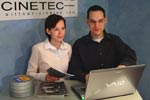
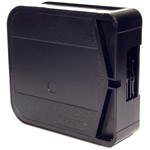
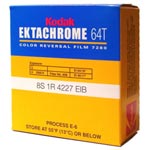
|
"We would be honored to have you visit our Super 8 factory in Windsor, Colorado" came the reply to our spontaneous inquiry regarding the possibility of visiting the Kodak production facility. Wow! Who´d have thought? In cases like these involving big companies, you assume that you will just get a standard reply, or be referred to an existing Visitor Center at best. You can understand why. When all´s said and done, a visit from outside people to the holy halls of production creates an amount of work for the company that is not to be under-estimated. Arrangements have to be made, production processes have to be rescheduled, or production suspended altogether. It all takes up time and manpower. So what an honor it was for us to receive a personal reply from Kodak´s Worldwide Product Manager. This promised to be a really special trip, not least because we´ve had a fascination for Super 8 filming ever since our school days. "We" means Claudia and Daniel Wittner, the two small film enthusiasts behind Wittner Cinetec, who, when in class 6, formed a filming team from friends and schoolmates and made (unintentionally) funny monster and science fiction Super 8 films in our parents´ attics on homemade sets, featuring lots of wild ideas and paper maché. Later on, a passionate hobby developed out of those early playful filming adventures. And since 1996, this has taken the form of a company, which has set itself the aim of making the use of small film easier over the decades to come. This is because, as early as 1988, we had already come to the sad realization that Super 8 and the other small film formats were fading from the public consciousness and disappearing from photo shops, and obtaining film and accessories was becoming more and more of a problem. The painful experience of wanting to film but having less and less equipment available spurred us on to contribute in some way so that the filmmakers of today might have a better time of it. Anyone who wants to make a film should be able to. This is the end goal behind all our efforts. And for anyone who has been so strongly rooted in films in general and Super 8 in particular, it can´t fail to be a really special day when you visit the firm that invented Super 8: Kodak - the biggest global supplier of film to both the amateur and professional market.
|
The Kodak Production Facility is just outside of Windsor, Colorado, at the foot of the Rocky Mountains, and approx 60 miles north of Denver. We did initially wonder if they would have their own "Kodak Street". In fact, the building is actually on "Eastman Park Drive", named after Kodak founder George Eastman. Kodak originated in 1892 from the Eastman Dry Plate Company, which had been started up by the inventor George Eastman and the businessman Henry Strong in 1881.
Although we arrived at the huge company premises well before the agreed time, our own personal welcome committee was already waiting for us at the security door. They welcomed us warmly, then handed out our visitor passes. After we had reported in to security, the heavy steel door opened and gave us a peek into the promising interior. We were in.
Huge and totally clean - that´s the first impression. Long corridors with mirror-like floors, order and control are the overriding impression. The office complex is in one area and the production halls in another. And there are black revolving doors known as light traps everywhere, leading to dark rooms. There are buzzing and humming sounds in the air, and it smells of fresh film. Every department sports a sign saying "16mm slitter", "Super 8 perforating" or "Finished goods supermarket". Now we know how close we are to the original source.
We are taken to the Production Plant Manager´s office first. He beams when he sees us and welcomes us warmly. He gives us a brief overview of the planned activities and we notice how well-prepared they are for our visit. First on the program is a teleconference with the World Wide Product Manager and the Communications Director of Entertainment Imaging in Rochester, New York. Right from the start we had expressed the wish to be allowed to take some photos. After a brief clarification of the type and scope of application, they agreed. Again, wow! They not only let us see everything - they let us take some photos, too. Definitely not a given. While we were chatting, we learned that they were moving the entire Super 8 and 16mm film production facility to the headquarters in Rochester. This is also where the emulsions are done - known as wide rolls, and it makes better logistical sense for Kodak to have the slitting and perforating done there, too in the future. We naturally asked all the usual questions like "Are you planning to discontinue Super 8 products?" and "Will the move affect the existing product range in any way?", although we could actually already sense how seriously they still treat the importance of small film at Kodak. The response is clear and unequivocal: Super 8 is here to stay, and for a long time yet. It is an important building block of the whole Entertainment Imaging sector, and one which they are not about to remove. Super 8 is important. Important for the next generation . Young people should have the chance to use real film. Students and film schools should continue to have an economical option for finding out about real film and learning to appreciate its merits. And older film makers should be able to go on filming. No ifs, ands, or buts. Kodak appreciates all film users, whatever format they use.
|
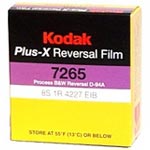
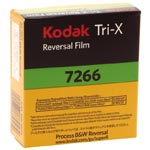

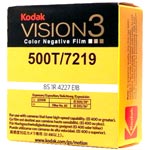
|
|
They take us to the conference room next, and we are rendered almost speechless. Part of the Super 8 and 16mm production team is waiting there for us. The workforce - 12 to15 film specialists - have come together to give us an overview of their Entertainment Imaging products - cine film products, naturally with the emphasis on small film - and answer our questions. The 16mm Film Finishing Operations Manager gave us a special presentation on Workflow, which he had prepared himself. We were deeply impressed. So many nice people, all mad about film and all in one place . So much warmth, enthusiasm and expert knowledge in one room. And we were part of it. We felt like we were at a Kodak family gathering. We are part of it, even though we have only just arrived.
|



|
Many of the team members accompanied us on the subsequent tour of all the Super 8 production departments, and each manager told us all about their work station and answered all our questions patiently. At the first station, the Super 8 cartridges are assembled from seven different parts. The plastic parts are manufactured in a nearby production facility using tools that are constantly renewed, and the metal spring for the pressure plate is stamped out of a band of metal on a special press and then curved with precision. All parts are subjected to exacting quality control at the production stage, and are checked again visually during assembly. The cartridges are assembled by hand in teams of two, who work with impressive speed and dexterity. The finished cartridges are inserted in the magazines, from which they will subsequently be removed to be loaded with film. They also assemble there the Super 8 cartridges for us, which we load with Super 8 film in Germany. They immediately thought of our order that happened to arrive on our doorstep in Hamburg a few days after our trip (see 07.04.2009 - Kodak cartridges arrive from new production). How wonderful it is that we now know where the cartridges come from, and even who checked and assembled them for us.
|
|
On our way to the first big darkroom zone, there was still time to talk about the pre-handling of film and cartridges, which ensures that film runs smoothly in the cartridges. In the first big darkroom, it was again evident how well their preparation for our visit had paid off. Production had already stopped, all the film had been stowed in light-proof containers and they´d turned all the lights on in the dark room, which was actually more like a "dark hall". In an adjoining room, the 54-inch (approx 1.3m) wide rolls, produced in Rochester, were slit into 16mm widths. One of these 2,000-foot (approx 600m) long rolls of 16mm film is already in the perforator, ready to be perforated for us into Double Super 8 (DS8) under normal light conditions. A stroboscopic light enables us to view this procedure as if in slow motion. The perforator punch goes up and down continuously, stamping the Super 8 perforations down each edge of the 16mm wide strip of unperforated film with extreme precision. So this is the workflow for Super 8 production: after the wide rolls have been slit, it starts with DS8! Wow again. Who´d have thought it? The perforator, a solidly built Bell+Howell, one of the several machines used by Kodak for Super 8 production, perforates the various types of film, from Ektachrome 64T to Tri-X / Plus-X, right up to Vision2 200T and Vision3 500T for use in Super 8 cartridges. And it also perforates Ektachrome 100D, which we obtain from Kodak as DS8 to slit ourselves and load into Super 8 cartridges.
|

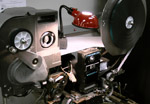

|
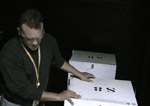


|
Our question about slitting takes us down endless corridors to the next darkroom zone. And again, employees are waiting, and the normal white light has been switched on so that we can see this stage happening live. A 2,000-foot roll of DS8 has already been put on the slitting machine, and deft hands are now threading it through the circular blades and numerous guide rollers . So that´s the second roll of film to see the light of day too early because of our visit. And the fact that they are sacrificing real film to show us how it works in normal lighting conditions isn´t a given, either. We are deeply impressed by their generosity with information, time and material, and their willingness to show us everything down to the last detail, and letting us experience it all close hand, and feel as happy as clams in the Kodak family.
One press on the start button on the slitting machine sets the whole technical wonder in motion. With a hiss and a hum, the rollers start to move with unbelievable speed. This machine specially made for Kodak takes just 90 seconds to slit a 2,000-foot / 600m roll of DS8 film into two strips of Super 8. Time for another WOW - no question!
|
|
In the meantime, we hardly notice that one of the other employees has prepared another machine for start-up. A machine that you could justifiably call the mother of Super 8 machines. Yes, you guessed it, I´m talking about the machine that fills the Super 8 cartridges with film. Remember? After the plastic parts and metal clips had been manufactured, the cartridges were assembled at the first station and inserted in magazines, and then the 16mm film was perforated into DS8 and slit into the Super 8 end product. We now have all the ingredients together in this one machine. The cartridge magazines are loaded into the machine and the Super 8 film is put on the big rollers. All of this happens right in front of our eyes, and we can still hardly believe it. Then it gets very noisy. The machine sets itself in motion and production begins. Each 50-foot /15.25m roll of film is rolled up at lightening speed and full automation. At the same time, one cartridge after another is removed from the magazine. All of the film gets the usual end stamp and "Exposed" imprint. The other end of the film is pressed on to the winding core of the cartridge. Meanwhile, successive cartridges are opened in the central loading unit of the machine, the roll of film inserted, and the film is fed into the cartridge, which is then closed up again and sealed against the light. After this, the notches (for the light meter and daylight filter if required) are stamped on. The filled and tightly sealed cartridges leave the machine on a conveyor belt to be gathered into magazines for transport. All of this happens as part of a continuous process, controlled by a complex guidance and control system, much of it pneumatic and some of it driven by small electric motors and countless sensors and diagnostic units. The cartridges are filled at a rate of 10 per minute, making 600 an hour. This trusty piece of equipment can turn out quite a few in a single shift. In the Super 8 heyday in the 1970´s, there were 12 of these machines in operation. Today, just one is enough. But don´t underestimate this "Super 8 mama". If required, she can pop out a huge amount of cartridges in one year. So - go film your hearts out! Many millions of linear feet of Super 8 film are still produced every year, and that´s how it should always be.
|





|




|
The filled Super 8 cartridges are then sent on to the inspection and packing area. The next stop on the Super 8 journey takes place under normal light conditions, even when the visitors have gone home. Here, we see the labeling machine and the verifier - an inspection device that checks each cartridge against various parameters. For example, it checks whether the proper light meter/filter notch has been stamped out. Likewise, the power required to advance the film is measured by applying highly specific torque to the winding core of the cartridge. This advances the film by 16 images. You can tell where this point is after the film is developed by the appearance of a fine red mark on the perforated edge. Then the film travels along the packing line, where it is sealed in the familiar aluminum-coated foil and finally put in cardboard boxes. At this point, an individual numerical code label is applied to the boxes. This code makes each individual cartridge traceable back to when it was produced, and on which machine. It contains the emulsion number of the wide roll and the slit, denoting the position of the 16mm roll of film when it was slit from the wide roll before being perforated into DS8. And there is an A or a B after the number to indicate which side of the DS8 film (after being divided on the slitter) is in the cartridge. The last steps consist of packing them 20 to a carton and palletizing them for the journey to the global distribution centers.
|
|
To round off the tour, they show us the three developing machines (ECN- 2, E6 and D94-A), which are only there to develop the test films that are exposed on a regular basis by Quality Control. This is one of the most important aspects of their work, and we came across it throughout the tour. These machines, specially built for Kodak, enable rapid development of all types of Super 8 and 16mm film. A huge plastic crate of marked and opened Super 8 cartridges is further evidence of regular monitoring and the attention paid to even the smallest film formats. Then they demonstrate the measuring devices that they use to make additional checks on the Super 8 cartridges if the need arises.
We learned an endless amount about Super 8, 16mm, Kodak and the photographic film industry in general on this tour. It completely did away with the unfounded perceptions you automatically have when you aren´t aware of the background. Like our assumption that Kodak probably only produced Super 8 cartridge once or twice a year. A huge amount in itself, but totally wrong! Super 8 production happens on a day to day basis. No material is produced just to be stored. This is just-in-time production technology. Of course, the distribution centers do always have a certain amount of reserves for filling daily orders. On a weekly or even daily basis, batches of film of all formats leave the Windsor factory to feed the distribution centers. This ensures that the film is always fresh, that production can keep running permanently and that there are no unnecessary storage volumes. We´re delighted to hear it. Isn´t it a good feeling to know that the Super 8 or 16mm film in the camera was produced for us film makers only a few weeks beforehand by these friendly people at Kodak? And that Super 8 is part of everyday business for everyone at Kodak, just like before? No languishing on the sidelines, as many had unjustly feared? Super 8 is part of the overall Kodak picture, and a solid component of the production planning strategy. Production will soon be relocating to Rochester, which means costs and investment! You can rest assured that Kodak wouldn´t move Super 8 production again if it weren´t important.
|





|
We hope that this report has given you an insight into the origins of all the well-known types of Super 8 film, and how seriously it is taken at Kodak. There is no place for the fears that keep flaring up about the imminent end of an era. Finally, we would like to say a big thank you to Kodak and all the employees involved in making this visit possible and making it an unforgettable experience for us. We have never had such a high-quality, professionally organized and yet personal Company tour as todays.
Thank you VERY much!
Kodak Entertainment Imaging website http://www.kodak.com/go/motion
Kodak Super 8 website http://www.kodak.com/go/super8
Kodak local sales offices http://www.kodak.com/go/salesoffices
Our current Super 8 film offer you will find under http://wittnercinetec.com/Super8cartridges
|
| |
|
 |
|
 |
|
| |
|
Wittner Kinotechnik © Wittner Cinetec GmbH & Co. KG Wittner Filmtechnik |
|
Impressum
|
| |
|
x x x x x x x x x x x x x x x x x x x x x x x x x x x x x x x x x x x x x x x x |






































